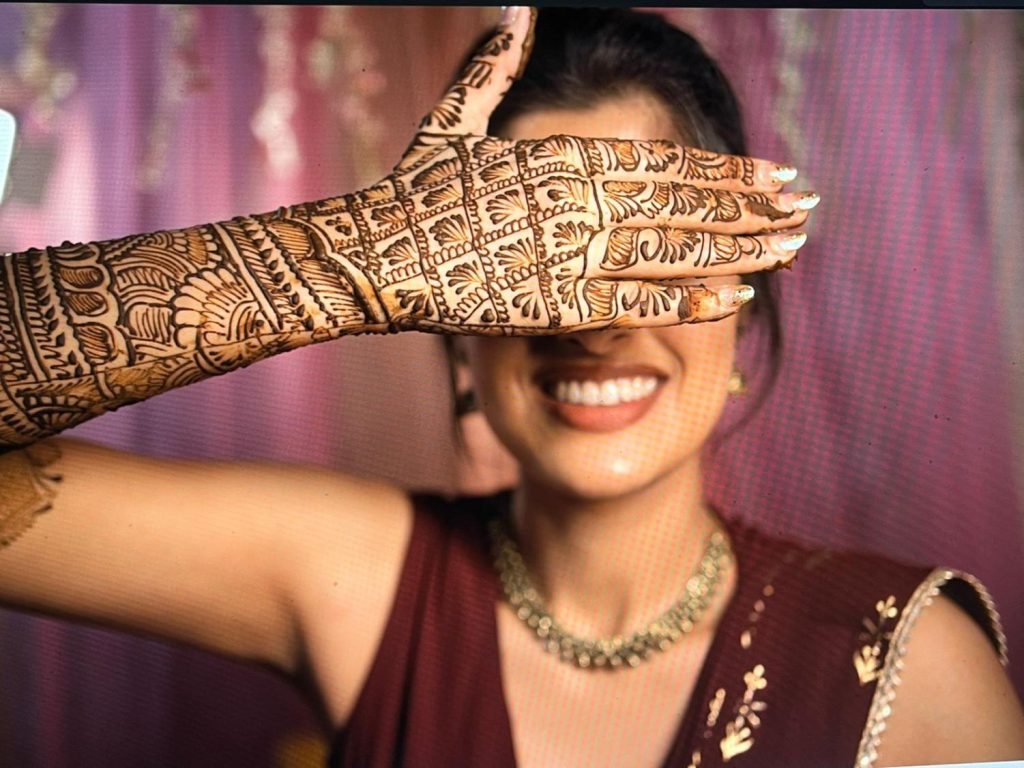Mehndi, also known as henna, is an ancient art form that has been practiced for centuries in various cultures around the world. It involves the application of a paste made from the crushed leaves of the henna plant to create intricate, temporary designs on the skin. While mehndi designs are often associated with weddings and celebratory occasions, they hold deep cultural significance that goes beyond mere aesthetics.
In many South Asian traditions, mehndi is an integral part of pre-wedding rituals, symbolizing love, fertility, and prosperity. The intricate patterns, often featuring floral motifs and paisley shapes, are meticulously applied to the bride’s hands and feet, representing her transition into a new phase of life. The darker the stain, the stronger the love between the couple is believed to be. This ancient practice not only beautifies the bride but also serves as a means of wishing her well on her journey into matrimony.
Beyond weddings, mehndi designs hold significant cultural and religious meanings in various communities. In the Hindu tradition, certain patterns and motifs are believed to invoke specific deities or represent auspicious symbols. For example, the swastika, an ancient symbol of well-being and good fortune, is a common motif found in mehndi designs.
In Muslim communities, mehndi is often applied during religious festivals like Eid and celebrations such as births and circumcision ceremonies. The art form is also practiced during the holy month of Muharram, where women gather to apply mehndi on each other’s hands as a form of solidarity and community bonding.
The Art of Mehndi Design
The art of mehndi design is a skillful craft that requires patience, steady hands, and a deep understanding of traditional motifs and patterns. Skilled henna artists, known as “mehndi waalis” or “mehndi experts,” undergo years of training to master the intricate techniques and styles.
One of the most fascinating aspects of mehndi design is the rich symbolism and meanings behind the various patterns and motifs. For instance, the peacock motif is often associated with luxury and beauty, while the lotus flower symbolizes purity and spiritual enlightenment. The incorporation of these symbolic elements adds depth and significance to the designs, making them more than just decorative adornments.
Read Also: Exploring the Beauty and Symbolism of Mandala Art
Mehndi designs can range from simple, delicate patterns to elaborate, intricate works of art that cover entire hands, feet, and even arms. The level of intricacy often depends on the occasion and the preferences of the individual. For weddings and major celebrations, more elaborate and detailed designs are favored, while simpler patterns may be chosen for everyday wear or casual occasions.
Comparison of Mehndi Styles Across Cultures
While mehndi is widely practiced across various cultures, each region has developed its own unique styles and traditions. Here’s a comparison table highlighting some of the distinct mehndi styles from different parts of the world:
| Region | Style Characteristics | Common Motifs |
|---|---|---|
| Indian Subcontinent | Intricate floral patterns, paisley designs, incorporating traditional symbols like the swastika, lotus, and peacock | Mandalas, paisleys, floral vines |
| Middle East | Geometric patterns, arabesque designs, incorporating Islamic calligraphy and symbols | Geometric shapes, Arabic calligraphy |
| North Africa | Bold, thick lines, incorporating Berber and Moorish influences, use of negative space | Berber symbols, geometric shapes |
| Southeast Asia | Delicate, fine lines, incorporating nature-inspired motifs like leaves and vines | Nature-inspired motifs, floral patterns |
This diversity in mehndi styles reflects the rich tapestry of cultural influences and artistic expressions across different regions. While the core practice of henna application remains the same, each culture has infused its own unique elements, making mehndi a truly global art form.
Mehndi in Modern Times
In recent years, mehndi has transcended its traditional boundaries and gained widespread popularity as a form of body art and self-expression. While still deeply rooted in cultural traditions, modern mehndi artists have pushed the boundaries of creativity, experimenting with new designs, techniques, and applications.
One notable trend is the fusion of traditional mehndi patterns with contemporary elements, such as incorporating quotes, portraits, or pop culture references into the designs. This fusion has given rise to a new generation of mehndi artists who blend traditional and modern influences, creating unique and personalized works of art.
Furthermore, mehndi has found its way into the fashion and beauty industries, with high-end brands collaborating with mehndi artists to create limited edition collections or incorporate henna designs into their product lines. This has not only brought mehndi into the mainstream but has also raised awareness and appreciation for this ancient art form.
Preserving a Cultural Legacy
Despite its growing popularity and modern adaptations, the preservation of traditional mehndi practices and knowledge remains crucial. Many organizations and communities are working to ensure that the rich cultural heritage and symbolism associated with mehndi designs are not lost or diluted.
Initiatives such as workshops, mehndi festivals, and educational programs aim to pass down the skills and knowledge of mehndi design to younger generations, ensuring the continuity of this cultural tradition. Additionally, efforts are being made to document and archive the diverse mehndi styles and patterns from various regions, preserving them for future generations.
Read Also: The Art of Henna: Traditions, Techniques, and Modern Twists
In conclusion, mehndi designs are more than just intricate patterns on the skin; they are a reflection of rich cultural heritage, symbolism, and artistic expression. From weddings and religious ceremonies to modern fashion and self-expression, mehndi has woven itself into the fabric of various cultures, serving as a vibrant reminder of the diversity and beauty that exists in our world.
As we continue to embrace and appreciate the cultural significance of mehndi designs, it is essential to preserve the traditional knowledge and skills that have been passed down through generations. By doing so, we not only honor the past but also ensure that this ancient art form continues to thrive and evolve, inspiring future generations with its intricate patterns and profound meanings.
In the lifestyle and fashion realms, mehndi designs offer a unique opportunity to embrace cultural diversity and personal expression. Whether adorning your hands and feet for a special occasion or incorporating mehndi-inspired motifs into your wardrobe or home decor, the beauty and symbolism of these designs add a touch of elegance and storytelling to your style.
As you explore the world of mehndi, remember to appreciate the rich tapestry of cultural influences and the skilled artistry behind each design. Embrace the opportunity to learn about the symbolic meanings and traditions, and let the intricate patterns inspire you to celebrate and embrace the diversity that surrounds us.

